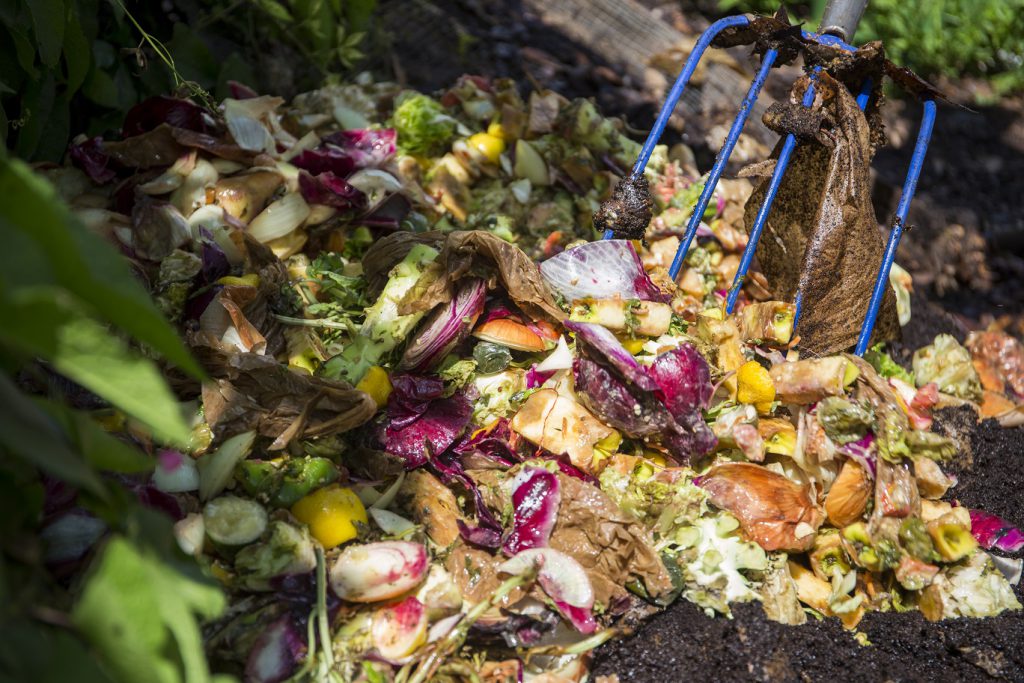Food waste is a huge problem here in the United States. Here are a few incredible facts: Food is the most common solid source of waste in American landfills. Anywhere from 25-40% of food grown, processed, and transported in the US will never be eaten. Food waste harms the environment and results in a lot of wasted money.
Looking for ways to reduce food waste? Just follow these six tips.
Plan meals carefully. Only purchase what will be eaten in a reasonable amount of time, especially perishable items. Buying large quantities of fresh produce, dairy, and other perishables may seem like a time-saving practice. However, throwing spoiled food away not only wastes money, but also time, since the spoiled items need to be replaced during another trip to the market.

Instead of throwing old fruits and vegetables away, turn them into nutrient-rich compost to help your garden thrive. (Photo source: Camila Guillen, UF/IFAS)
Freeze or re-use food whenever possible. Not all food freezes well. However, fresh fruits and vegetables freeze quickly and easily when handled properly and can last in the freezer for months. Vegetable scraps are also great for making compost, which enriches the soil and can help support the growth of backyard gardens.
Look at the sell by/use by/best by dates on food products. Try to purchase items with the longest shelf-life (the latest date) available. If a product is close to its sell by date, be sure to use it or freeze it quickly. Keep in mind, however, that just because a product is past its use by date does not mean it is unsafe to eat. Take it on a case-by-case basis. If there is no mold, pests, off odors, off colors, or off textures, the product is safe to consume. This is especially true for dry, non-perishable items.
Store food properly. Storing foods at the wrong temperatures can speed up the spoilage process. Keep the refrigerator between 37 and 39 degrees Fahrenheit. Dry goods storage should ideally be around 50 degrees F, but since this is not realistic for most of us, just make sure dry goods are stored in a cool, dry place outside of direct sunlight.
Stay organized. Arrange items so that the oldest stuff is in front. This helps ensure it is used first. Always label frozen foods with the item name and date it was first frozen and use within 12 months whenever possible. Foods frozen for longer than a year start to diminish in flavor and texture. Old food also tends to attract pests, so making sure things are used efficiently can help eliminate the risk of insects and rodents.
Donate non-perishables to those in need. Food banks and other community organizations are always looking for food donations to help the hungry. Non-perishable foods that have not surpassed their use by/sell by dates are always welcome donations. Instead of trashing it, share it with someone less fortunate.
In most cases, food affected by flood damage or other disasters should be discarded for safety reasons. Better to be safe than sorry. However, everyday food waste is completely avoidable if a few simple rules are followed. The amount of food thrown away each year in the US is disheartening. When shopping, being a little more mindful of quantities and dates can help reduce overall food waste, saving both money and the environment.
Additional Resources:
National Center for Home Food Preservation (University of Georgia Extension)
Food Waste Resources (Kansas State University Extension)
UF/IFAS is an Equal Opportunity Institution.
- Plugging Spending Leaks - October 24, 2025
- Pets are Good for Mental Health - September 26, 2025
- Develop a Family Emergency Plan for Hurricane Season - June 30, 2025
